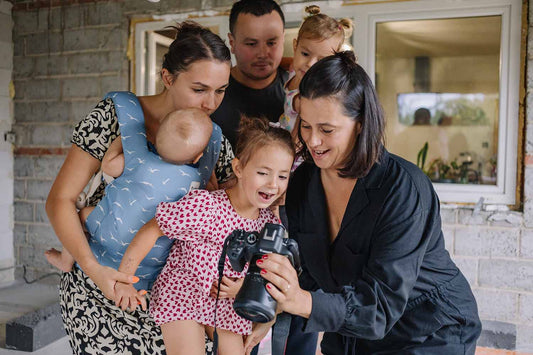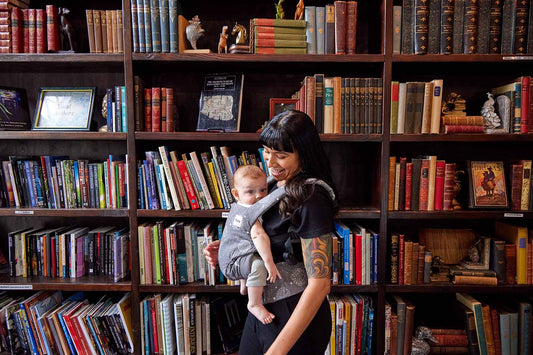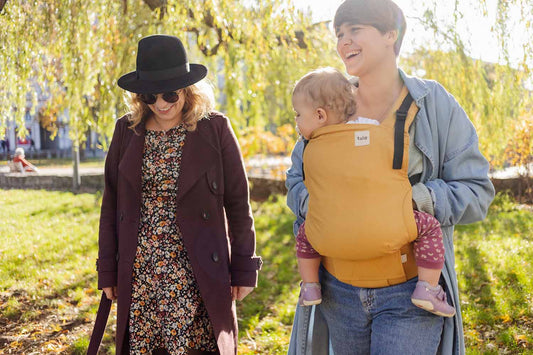My Plus-Size Babywearing Journey
Chances are, if you are finding this blog, you are looking for positive plus-size babywearing experiences. But this is an honest description of my personal journey. The difficulty I had in finding a carrier that works may even be triggering. As many of us know, being in a larger body isn't always accommodated as well as it should be. When you factor in the newness and vulnerability of becoming a mother, it can be enough to abandon the idea of babywearing altogether.

But, if I did that, I would have missed out on an essential parenting tool that has been so important to me. Nothing had a more significant impact on my 4th trimester and beyond than a good carrier. So, I am writing this because I don't want you to miss out even for a moment on the time that you get to hold your baby close. I hope this will help you find the right carrier that gives you the confidence and opportunities every parent deserves.
Before we dive too deep, here's a little bit about me. I am a mother to two children (7.5 years apart), and I’m definitively plus-size. I say that because I find the term co-opted by people who consider themselves fat, but "feeling fat" is not a size.
I am a US dress size 22/24, and the largest measurement on my abdomen is 52 inches. I can't wear "straight-size" clothing. I can't shop at 90% of the stores at our local malls. Hopefully, this transparency helps you better understand my experience as I set out to find a baby carrier that worked for my body.

We deserve to wear our babies too!
Once it clicked, babywearing made me feel not just capable, but it made me feel like a superhero. I could meet my baby's needs and walk down the street with my hands-free. It helped me feel light (mentally) when I didn't have to push around what sometimes felt like a mobile baby apartment. It may be counterintuitive to some, but having my baby on my body actually makes me and other babywearers feel unencumbered.
When I welcomed my second, the value of being able to carry them in a baby carrier increased exponentially. I could keep up with my oldest child's needs for attention and connection while I nursed on demand in the baby carrier. I could still hold her hand when I needed to because my (both!) hands were free.

This is not just an experience unique to me. The research available shows babywearing benefits both the baby and the caregiver in many ways, from decreased crying to increased responsiveness, lactation success, and attachment central to making you more attentive and caring.
So instead of taking you on my journey to find what fit, let's follow the TikTok trend and "skip to the good part"! Like me, you might have been given or tried a baby carrier that wasn’t the best fit for you body, but here are carrier options for us—great ones.
There are simple, intuitive, and comfortable options that can easily be shared between you and a partner of a different size. When looking for your carrier, I suggest you start with these tips:
- Look at the measurements. Waistband measurements do not tell the whole story, but it is a start. I recommend measuring around the largest point between your waist and hips.
- Look for adjustability. Can the carrier be shared between people of different sizes?
- What's the return policy? Amazon is not your only option for returning a carrier that doesn't fit and is not my favorite place to shop for baby carriers.
- Seek out the local babywearing professionals in your area. Typing "babywearing (your state/city)" into Facebook will help, or you can use babywearinghelp.org. They may be able to offer suggestions and an opportunity to try something before you buy.
- Join size-friendly parenting spaces online. You’ll find a community ready and willing to help you!

After some trial (and error), not only did I find a way to wear my kids with ease between sizes 18 and 24 (and far beyond if I ever need it), but six years ago, I also became a professional babywearing educator. This way, I could help others find joy and ease in carrying too.
Through that training and work, I have tried over 50 carrier options and did hundreds of carrier fittings. Through all of that, I learned that Baby Tula carriers are what fit my body and supported me the best. They accommodate not just my waist size, but I didn't have to squeeze into the arm straps as I did with other options that claimed to be size inclusive. In Tula, I am fortunate to have found an entire line of carriers that didn't leave me out. While I have slight preferences between the different Tula carriers, I can proudly say that all their carrier options comfortably fit.
Will It Fit: XXS to XXXXXL
I love that Tula carriers fit me at a US size 22/24, but as a babywearing educator who helps others find the right carrier, I am thrilled that these carriers are so inclusive. In a perfect world, I would love to meet with every caregiver and do a carrier fitting with several options to see what will be the most comfortable and most effortless for them to use.

Many people buy their first carrier, which doesn't quite meet their expectations. They thought it would be more supportive, fit better, and be easier to use. Unfortunately, those are all things that are hard to decipher when looking at a registry list. The next best thing to a personalized fitting appointment with a professional is a carrier that is universally simple to use, accessible to buy, grows with your baby, and fits a wide range of bodies well.
I have found myself recommending the Tula Free-to-Grow, and for those that want a forward-facing position, the Tula Explore baby carrier over and over to people of all sizes. People are often shocked to learn that my older daughter, by around age nine, could wear her little sister in the same carrier I do. She got the same comfortable and supportive fit well under 100 pounds as I do over 320 pounds.

Fit by the numbers: The Tula Waistband Measurements
The waistbelts on the Tula Free-to-Grow, Explore, and Tula Lite are 57 inches. The waistbelts on Standard, Toddler, and Preschool Tulas are 61 inches. Those lengths will fit most wearers through US dress size 26 and will fit some up to size 32. While those sizes are some of the most inclusive on the market already, in 2022, Baby Tula introduced a 10-inch waistbelt extender to include even more caregivers. You can add a waistbelt extender for free to a carrier order on the website, or if you already have the carrier, you can order one for $10.

Remember, being plus-size doesn't mean you need the extender.
If you are size 16-24, you don't have to give it a second thought. However, if you are size 26+, it's wise to measure at the point of your body where your carrier will sit and see if you would benefit from the extra 10 inches.
The Features that Make Tula Size-Inclusive
We already talked about the waistband, but that alone does not make a carrier size-inclusive.
Here are some other features that make Tula a size-inclusive option:
- Arm strap length - The arm straps and chest-clip both have extra webbing so the carrier can cinch down and expand to fit bodies of different sizes. It also makes the chest clip easier to reach right at the nape of your neck.
- Adjustability - The Free-to-Grow and Explore both adjust to fit a growing baby, but those adjustments are separate from the adjustments to fit their caregiver. A person who is size XS can share a carrier with someone XXXXL and not affect the fit on baby.
- Arm padding - The padding section on the straps is longer than some other carriers. For example, it is 24 inches on the Free-to-Grow.
- Buckle placement - Your Tula waistband will secure with a buckle closer to one side of your body, making it easier to reach.
Finding The Right Carrier For Me… (hint: Tula)
I became a mother 11 years ago, and, like many other parents, I was woefully unprepared. As a mother on a low-income budget, I found the baby registry process somewhat stressful and confusing. Did my baby really need so many things?
I couldn't tell a need from a gimmick. Everything seemed necessary, and I didn't know what to prioritize. Unfortunately, I didn't know to prioritize babywearing. Like many expecting families, someone had handed us a pile of old buckle carriers, so I didn't even register for a baby carrier. It's funny because now I tell people to put babywearing near the top of their list of priorities! We are told to buy so many items to place baby down in. But, in my experience, babies just want to be held.
While I was grateful for the hand-me-downs, the 10-year-old harness-style carriers weren't the best representation of babywearing for my body. When I would try to wear one of the hand-me-down carriers, it was confusing and didn't fit my body correctly. I didn't get to wear my first baby as a newborn, and I know it would have been so helpful for both of us.
I started researching carriers just from a practical standpoint. We were a single-car family living in an upstairs apartment. If I wanted to get out of the house, it would be on foot, so a baby carrier made sense. So I decided and had my heart set on the most popular carrier of the era. I visited shops that carried them and waited months until it was tax refund time and I could finally buy it.
At this point, I was only about a size 14/16. I wasn't even truly plus size. I had no reason to doubt that this popular high-end brand would fit me. The day I finally picked it up from the baby store, I tried it on at home, and it was so tight that it physically hurt. I was so determined to make it work that I wore it anyway until I could purchase an extender.
This was not my last encounter with a baby carrier that wasn't size-inclusive, but it was probably my most impactful because it was at a time when my body was in physical transition. I hadn't yet embraced and appreciated my body; this reminded me that it had changed. After having a baby, fatphobia messaging is already hovering around, looking to collect us as we are inundated with messaging about "bouncing back." Feeling even for a moment like you are too big for a basic parenting item, like a baby carrier, doesn't help.

The good news is that the snug carrier didn't stop me from starting a deeper babywearing journey. I used that carrier until my very tall daughter was 22 months old. We adventured daily around the neighborhood, and I didn't want it to stop. My daughter was safely up on my back, and it fit into our lifestyle perfectly. That is when I was introduced to a local brand called Tula. It was new and up and coming but gaining popularity extremely fast. The prints were adorable, they made a toddler-size carrier, and the most crucial feature of their carriers: I heard they were much more size-inclusive.
I saved up to make my first Tula purchase, but because of their extreme popularity at that time, the carriers were often sold out. Looking back, I wonder how many people desperate for a Tula were like me and just wanted something that would fit. Seeing people as large as size 32 in a Tula carrier gave me the confidence that they would certainly fit my changing body. My very first Tula purchase was all the way back in 2014. I bought a Toddler Tula in the print Ahoy Matey and adored it.
One would think that most carriers would be size inclusive this many years later, but that isn't necessarily the case. While I am far more confident now and have the resources and connections to toss aside a carrier that doesn't fit, I still put myself in the shoes of a new, unsuspecting, first-time, plus-size caregiver. I refuse to blame my body when the fact is the average US women's dress size is between 16 and 18. It seems egregious and intentional for a baby carrier to not even fit the AVERAGE-sized woman. In an age where brands heavily depend on social media depictions of their customer's content, I wonder if making small carriers curates the "perfect" feed for them.

This isn't about companies, though. It's about parents. It's about the scientific benefits of babywearing that are critical to our species. It's about over 30% of new mothers who suffer from PPD/PPA. It's about how many people try a carrier that won't meet their needs and just give up.
The benefits of babywearing should be accessible and attainable to as many people as possible regardless of size.
I am so happy that Tula now offers a waistbelt extender. Over the years, I've been proud to tell people that Tula fits "most people." "Most people" now includes ten more inches than it did before. The extender blends right into the waistband and doesn't make the carrier harder to use. It also allows for all of Tula's stunning prints and specialty textile options to be available to everyone vs. having a narrower collection just for extended sizes. At the same time, the same carrier is still petite-friendly. Is it magic? Probably not. I guess sometimes inclusivity can feel that way, though.

Check out what's new from Tula here.

This guest blog was written by Tiffany Graves. Tiffany has taught babywearing professionally since taking the Center for Babywearing Studies course in 2016 but has worn her own children since 2011. She is a board member for the non-profit babywearing outreach group, San Diego Carries, where she provides free hands-on help for people who want to learn to use a carrier. Tiffany's skillset for instruction and carrier fitting came from her work in a fast-paced babywearing specialty store where she assisted hundreds of families in ensuring they could successfully and comfortably wear their babies. In 2020, Tiffany joined Team Tula part-time from home, working in education while enjoying an unschooling life with her two children.






